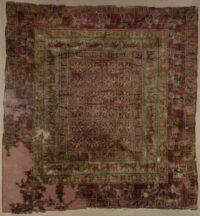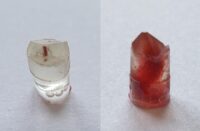 The secret to the persistence of the brilliant colors in the world’s most ancient pile carpet has been discovered: fermented wool. The sheep wool carpet now in the collection of the Hermitage Museum dates to around 400 B.C., making it six centuries older than the next oldest dated examples of pile carpets. The carpet is in exceptional condition, preserved in the permafrost with only small areas of loss. The reds, blues and yellows are still vivid.
The secret to the persistence of the brilliant colors in the world’s most ancient pile carpet has been discovered: fermented wool. The sheep wool carpet now in the collection of the Hermitage Museum dates to around 400 B.C., making it six centuries older than the next oldest dated examples of pile carpets. The carpet is in exceptional condition, preserved in the permafrost with only small areas of loss. The reds, blues and yellows are still vivid.
It was discovered in a 1947 excavation of the largest burial mound of the Pazyryk culture in the Altai mountains of what is now Kazakhstan. It is unique on the archaeological record, although there is a comparable piece of Persian origin, suggesting that it may have reached Altai region via trade networks or perhaps been made locally by copying a Persian piece. It was knotted with the symmetrical double knot, a technique also known as the Turkish knot, which creates an exceptionally dense pile.
In the central field has six rows and four columns of boxes, each containing stylized lotus buds arranged in a cross shape. Around the central field are five borders. The first features 28 boxes containing griffins. The second is a wide band with 24 fallow deer bucks grazing. The third is a thinner band with lotuses again but smaller and red against a yellow background. The fourth is the widest to make room for 28 horsemen, both mounted and dismounted, against a rich crimson background. The outer band features the boxed griffins of the inner border.
To investigate the remarkably enduring color of the carpet’s colors, researchers at Friedrich-Alexander-Universität Erlangen-Nürnberg (FAU) penetrated deep into the knots of the carpet using high-resolution X-ray fluorescence microscopy (µ-XRF) to analyze the distribution of pigments in a cross-section of individual fibers. This is the first use of the technology on carpet fibers; previous studies in the field have all used scanning electron microscopy (SEM). Indeed, FAU researchers already had samples of the carpet because they had been sent to them for SEM analysis in 1991.
SEM imaging can identify fermented wool from its raised outermost cuticle layer, but that only works with newer textiles because the outer cuticle layer wears off over time. The surface of the Pazyryk carpet’s fibers is damaged with the cuticle layer missing entirely in some areas, as one would expect for a textile that was woven 2,400 years ago.
 Into the breach stepped µ-XRF. Samples of fibers from the Pazyryk carpet dyed with red madder were embedded in epoxy and cross-sectioned for scanning. For comparison, recently prepared wool was obtained from Anatolian weavers and fermented according to the traditional technique, and samples were taken from an 18th century Konya carpet.
Into the breach stepped µ-XRF. Samples of fibers from the Pazyryk carpet dyed with red madder were embedded in epoxy and cross-sectioned for scanning. For comparison, recently prepared wool was obtained from Anatolian weavers and fermented according to the traditional technique, and samples were taken from an 18th century Konya carpet.
We conclude from our studies that both the eighteenth century Konya carpet and the Pazyryk carpet have been manufactured from wool that was fermented prior to dyeing. This means that the people of the Pazyryk culture not only already had sophisticated knowledge about pile carpets, but were also highly skilful textile dyers achieving colour fastness superior to modern industrial production. Our results also proof that the fermentation technique was in ancient times not only restricted to Eastern Anatolia and may have played an important role in traditional dyeing craftsmanship.
The way fermentation works is the wool is soaked in a suspension in sourdough and wheat bran which feeds a beneficial culture of G. candidum yeast. The microorganisms keep the pH steady at 4.4, prevent putrefaction and after about three weeks, decompose the fats inside the cuticle layer greatly enhancing the wool fibers’ ability to absorb the dye. It is a more effective and cheaper means to maintain color fastness than bleaching, but it does have certain downsides. It takes a long time and if you don’t get the fermentation balance, you end up with putrefied wool. (I had a batch of fermented hard boiled eggs go wrong once, and my ferments were messed up for months after that. Fermentation is beautiful and terrible as the dawn. All shall love it and despair.) The Pazyryk carpet’s intense, vibrant color shows why it’s a risk worth taking.